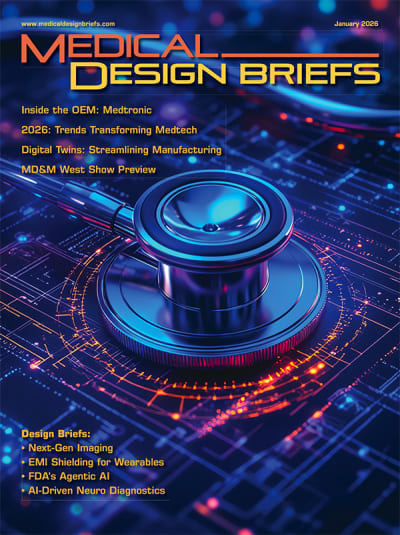
Healthcare facilities and providers are the beneficiaries of impressive advances in therapeutic technologies that push the boundaries of what’s possible in patient care. Wearable devices have evolved from tracking personal fitness statistics to functioning as a direct conduit from patients to providers for diagnostic, monitoring, and treatment analysis. Artificial intelligence (AI) is currently a major driver of imaging, diagnosis, and treatment of oncology-, cardiac-, and diabetes-related conditions, among many others.
Given the nature of these evolving treatment technologies, the need for more data, computing power, and bandwidth is growing exponentially. That said, the ecosystem for developing breakthrough healthcare products calls for advanced manufacturing technologies and strategies. Picture a manufacturing operation with end-to-end digitization and a manufacturing execution system (MES) on every product line and in every site. Then add the full integration of all your other management systems, such as enterprise resource planning (ERP), quality management system (QMS), laboratory information management system (LIMS), etc., providing complete visibility up and down the supply chain.
Using advanced data analytics within MES software equips you with the necessary information to identify actual cycle times and exactly how long it takes to execute a device history record (DHR), making the production schedule complete and more accurate. With the easy retrieval of data from a single source, you can also more easily determine how to change processes to continually improve production and optimize lead times.
Incentives for Digitization
The ability for any company to keep pace with the evolving life sciences industry and advanced methods of patient care depends on how well it incorporates these next-generation technologies into product development. However, it’s surprising that a large number of companies are still using manual, paper-based processes in their manufacturing operations.
MasterControl recently conducted a study on the level of digitization life sciences companies are deploying in their manufacturing and quality management operations.1 The company spoke with 152 life sciences manufacturing professionals in medical device, pharmaceutical, biologics, and biotech. The objective was to learn why companies in one of the most innovative industries are still putting pen to paper and using outmoded manufacturing management processes on their production lines. Using a self-assessment and a multiphase digital progression process called the Digital Manufacturing Maturity Model, the participants were able to accurately derive their level of digitization (digital maturity) in their manufacturing operations in comparison to their industry peers.
The research shows that digitization is a high priority for companies. The majority of respondents cited that they are actively pursuing a digital transformation but still have not advanced to their desired level of digital maturity to achieve optimal production performance.
Paper Imposes Limitations on a Manufacturing Operation
Companies that are slow to adopt digital technologies risk not reaching their full potential as a contributor to the life sciences value chain. Data from the survey revealed that 64 percent of the participants cite the inefficiencies of a manual, paper-based operation as one of their biggest challenges in meeting key performance indicators (KPIs) and production demands. Given the urgency of getting devices to patients, life sciences products are time sensitive. The challenges inherent in product manufacturing are further compounded by having to navigate a difficult regulatory pathway.
Medtech product manufacturers are under significant pressure to meet the numerous regulatory and good manufacturing practice (GMP) guidelines. Compliance involves factoring in a variety of aspects that impact their product, including quality, human factors, safety, reliability, environmental conditions of where the device will be used, etc. Stakeholders from the organization’s multiple business units all need to understand the full scope of the product’s life cycle. Part of this includes making efficient use of data — an added challenge when the data is siloed in various locations.
Gathering and analyzing critical data from disparate paper sources creates unnecessary obstacles. For starters, key stakeholders don’t have information until it comes to them, so they lack work-in-progress visibility of key areas along the supply chain. Unless the data is current and accurate, it’s difficult to identify trends, leading to delayed and uninformed decisions. Also, unstructured data in paper form often doesn’t include the data’s history or context. Locating this information is time-consuming, which extends lead times on critical changes. Certain tasks such as coordinating resources and production schedules require precise timing. Companies can actually lose money when they can’t get data to the right place at the right time.
Records management in a paper-based environment is difficult. Production records can contain 1,000 or more manual entries — using up reams of paper. Various team members need to review the records multiple times to ensure completeness and accuracy, which pulls them away from research and development and other business-critical projects. The risk of errors on production reports increases with each human touch point, such as illegible penmanship, numerous changes that need to be noted and signed, and smudged ink. The costs of the production setbacks, product damage, and waste resulting from these issues add up quickly. All of this leads to life-changing products not reaching patients in a timely fashion.
A Paper-Based Operation Impacts Quality
Ideally, quality should be embedded in every phase of manufacturing. However, manufacturing and quality departments commonly have competing priorities. Regardless, these business units need to have clear, holistic visibility of how the project is progressing as well as maintain transparency and communication to achieve their objectives. If quality doesn’t come in until near the end of production, it’s an added process and an added expense because it’s not incorporated into the production cycle.
The quality staff commonly need to spend an extensive amount of time double-checking spreadsheets and paper documents. Issues are often discovered that should have been identified much earlier or should not even exist, resulting in the product being scrapped or reworked. Because quality issues stem from variables that become more complicated as products progress through development and manufacturing, the cost of fixing problems increases incrementally the further the product is in its life cycle.
It’s overwhelming to track every aspect of quality events across the organization and know how they affect the production process — especially when quality data is isolated in an unstructured format. In the event of a deviation, corrective action/preventive action (CAPA), or some other quality event that results in process changes, the related work instructions need to be updated and approved, which can take up to 30 days or longer. Then all previous versions need to be found and taken out of circulation. Updates to documentation means employees must be trained on the new processes before performing the tasks or it becomes a compliance issue. Meanwhile, production slows or comes to a halt until all the issues are resolved.
What Blocks Manufacturers from Transitioning to a Digital Operation?
Despite the incentives and benefits of digitizing operations, the survey indicated that many companies are delaying or opting out of modernization for a number of reasons. For starters, the survey showed that 47 percent of the participants cited that the price of a new solution is the primary reason for not pursuing a digital transition.
A technology upgrade requires some changes to your current environment and processes. The survey showed that 43 percent of the participants considered the disruption of operations their main impetus for not upgrading. Completing the setup, configuration, transferring data, and training staff on the new system requires a lot of effort — not to mention pulls people out of their comfort zone.
Another reason for postponing a digital migration is that change can be time-consuming, as cited by 34 percent of the participants. For example, a traditional MES takes nearly two years to set up, configure, and incorporate into a company’s manufacturing operation. Production doesn’t need to completely stop, but it will slow down during the transition.
Overcoming the Blockers: Advantages of a Digital Transformation
As stated, the most popular argument for delaying a digital transformation is the cost. To put it in a different perspective, one of the leading contributors to production delays, compliance issues, and product recalls is human error. The escalating prices of raw materials and components is putting pressure on companies to reduce costs on their end. Investing in upgrading equipment and technology is the route to cost-effective, intelligent manufacturing. The elimination of human error alone results in a significant cost savings in a short amount of time and well outstrips the cost of new systems.
Advanced technology has accelerated system setup and deployment processes. For example, a modern, lightweight MES technology takes as few as 90 days to implement. It’s designed to adapt to your operation, so digitized production records can emulate what your operators are used to seeing and working with in their job responsibilities. This means you shorten production cycles and lead times and recognize ROI sooner.
An Era of Connectivity, Advanced Analytics, and Automation
Digitized manufacturing operations embed intelligence and connectivity into your manufacturing ecosystem. The ability to gather and analyze high-quality, real-time data enhances manufacturing performance from raw materials to finished products. Business units, such as quality and manufacturing departments, become more unified, which helps foster cross-departmental communication throughout the organization.
The digitized manufacturing environment is here and continues to gain momentum. For many companies in the life sciences arena, industry 4.0 is a business strategy. Overall, 63 percent cited that digital maturity is a competitive differentiator. It aligns the people and culture with the organization’s mission and objectives and better positions the company for future success.
Reference
- “The State of Digital Maturity in Pharma and Medtech Manufacturing,” Master Control, 2023.
This article was written by Matt Lowe, Chief Strategy Officer, MasterControl, Salt Lake City, UT. Lowe is a medical device expert with experience in product development and product management at Ortho Development Corp. and Bard Access Systems, a subsidiary of BD. Lowe has successfully launched more than a dozen medical devices. For more information, contact



